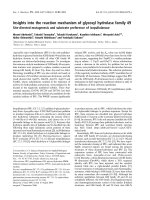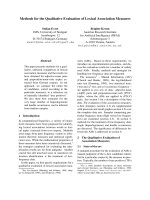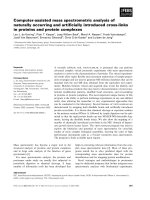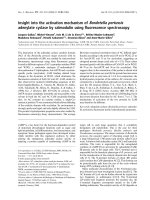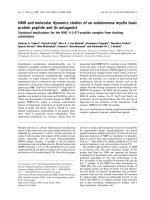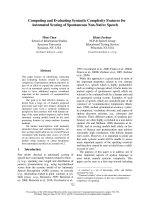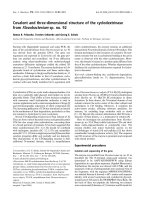Báo cáo khoa học: "LEXICON-GRAMMAR AND THE SYNTACTIC ANALYSIS OF FRENCH" pot
Bạn đang xem bản rút gọn của tài liệu. Xem và tải ngay bản đầy đủ của tài liệu tại đây (506.96 KB, 8 trang )
LEXICON-GRAMMAR AND THE SYNTACTIC ANALYSIS OF FRENCH
Maurice Gross
Laboretoire d'Automatique Documentsire et Linguistique
University of Paris 7
2 place Jussieu
75251 Paris CEDEX 05
France
ABSTRACT
A lexicon-grammar is constituted ot the elementary sentences of
a language. Instead of considering words as basic syntactic units
to which grammatical information is attached, we use simple
sentences (subject-verb-objects) as dictionary entries, Hence, s
full dictionary item is a simple sentence with a description of the
corresponding distributional and transformational properties,
The systematic study of French has led to an organization of
its lexicon-grammar based on three main components:
- the lexicon-grammar of free sentences, that is, of sentences whose
verb imposes selactionel restrictions on its subject and complements
(e.g. to fall, to eat, to watch),
- the lexicon-grammar of frozen or idiomatic expressions (e.g.
N takes N into account, N faiaea a question,
- the lexicon-grammar ot support verbs. These verbs do not have the
common selactional restrictions, but more complex dependencies
between subject and complement (e.g. to have, to make in
N has an impact on N, N makes a certain impression on N)
These three components interact in specific ways. We present
the structure of the lexicon-grammar built for French and we discuss
its algorithmic implications for parsing.
The construction of a lexicon-grammar of French has led to an
accumulation of linguistic information that should significantly
bear on the procedures ot automatic analysis of natural languages.
We shall present the structure of a lexicon-grammar built for French
<2> and will discuss its algorithmic main implications.
1. VERBS
The syntactic properties of French verbs have been limited in
terms of the size of sentences, that is, by restricting the type of
complements to object complements. We considered 3 main types of
objects: direct, and with prepositions ~ and de. Verbs have
been selected from current dictionaries according to the
reproducibility of the syntactic judgments carried out on them by a
team of linguists. A set of about 10~000 verbs has thus been
studied.
The properties systematically studied for each verb are the
standard ones:
1 E.R.A. 247 of the C.N.R.S. afiliated to the Universities Paris
7 and Paris Viii.
2 Publication of the lexicon-grammar is under way. The main
segments available are: Boons, Guillet, Lecldre 1976a, 1976b and
Gross 1975 for French verbs, Giry-Schneider 1978, A. Meunier 1981,
de Ndgroni 1978, for nominalizations,
- distributional properties, such as human or non human nouns, and
their pronominal shapes (definite, relative, interrogative pronouns
<3>, clitics), possibility of sentential subjects and complements
que • (that S), ai 3 (whether S, if S) or reduced infinitive
forms
noted V Comp,
transformational properties, such as passive, extraposition,
clit icization, etc,
/~logether, 500 properties have been checked against the 1~000
verbs <4>.
More precisely, each property can be viewed as a sentence form.
Consider for example the transitive structure
(1) N O V N 1
We are using Z.S. Harris' notation for sentence structure: noun
phrases are indexed by numerical subscripts, starting with the
subject indexed by 0. We can note the property "human subject" in
the following equivalent ways:
(2) Nhum V N 1 or N O (:: Nhum) V N t
w~ere the symbol :: is used to specify a structure . A passive
structure will be noted
(3) N I be V-ed by N O
A transformation is a relation between two structures noted "=°':
(1) = (3) corresponds to the Passive rule
The syntactic information attached to simple sentences can thus be
represented in a uniform way by means ot binary matrix (Table 1).
Each row ot the matrix corresponds to a verb, each column to a
sentence form. When a verb enters into a sentence form, a "+" sign
is placed at the intersection of the corresponding row and column,
if not s "-" sagn. The description of the French verbs does not
have the shape of a 10,000x500 matrix. Because of its redundancy
(cf. note 4 1, the matrix has been broken down into about 50
submatrices whose size is 200x40 on the average. It is such a
system of submatrices that we
call a
lexicon-grammar.
J Actually, the shape of interrogative pronouns: qu~ (who),
que-quoi (what) has been used to define a formal notion of
object.
4 Not all properties are relevant to each of the 10~000 verbs.
For
example, the properties of clitics associated to object
complements are irrelevant to intransitive verbs.
275
i!tt
I
dt~-,
='eml:~l,¢
- - - ='em~
4- -+ + 4- 4. - ;'e~lmmmr
+-4.4-+ b~km
- + ÷ - :=pkmr
+ - - - m f~
+
+-4"4-
4
+-+-
+-
+-+-
+-++
@
+
N I
:tz i z I =" Iz I z I z I =. };
-4"- + +-
+-
-
+!
4=
+
+-+ i
4= ++-@-+-4"
o==u~ ++-+-++
4"+ +-++
4
e=
- -+ 4-I
de - -÷-4 i
4= -÷ +-+
.I > I~.
z:lz~
-ii
+
÷
÷
+
- -]rm~ + + - + - + -
4.
,~=
-ear~
2-+;;
.++'-*-
+
; - 4 @-
-l|uW dkw==¢ + + +
Intransitive Verbs (From Boons. GuilipP. r~l "~
S, Guillet, 5ecl~re 1976a)
Table 1
Although the 3 prepositions "zero", a and
de
ere felt and
described as the basic ones by traditional grammarians, the
descriptions have never received any objective bee,s. The
lexicon-grammar we have constructed provides s general picture of
the shapes of obleCts tn French. The numerical distr,butlon of
oblect patterns is given ,n table 2, according to their number in a
sentence and to their preposlhonal shape.
N O V
N O V N 1
NoV&N 1
N O V de N I
N O V N 1 N 2
N O V N 1 ~= N 2
N O V N 1 de N 2
NoV&N1 &N 2
N O V & N 1 de N 2
N O V de N 1 de N 2
!,800
3,700
350
500
150
1,600
1,900
3
10
1
DISTRIBUTION OF OBJECTS
Table 2
AS can be seen on table 2,
direct
oblects are the most numerous in
the JPXlCOn. Also, we have not observed a single example of verbs
with 30blects according to our definition.
In 2. and
3.
we will make more precise the lexicel nature of
the Nl's attached to the verbs.
The signs in a row of the matrix provides the syntactic
paradigm of a verb, that is, the sentence forms into which the verb
may enter. The lexicon-grammar is in computer form. Thus, by
sorting the rows of signs, one can construct equivalence classes for
verbs: Two verbs are in the same class if their two rows of signs
are identical.
We have obtained the following result: for 10,000 verbs there
are about 8,000 classes.
On the average, each class contains 1.25 verb. This
statistical result can easily be strengthened. When one studies the
classes that contain more than one verb, it is always possible to
find syntactic properties not yet in the matrix and that will
separate the verbs. Hence, it our description were extended, each
verb would have • unique syntactic paradigm.
Thus, the correspondence between a verb morpheme end the set of
sentence forms where it may occur is one-to-one.
Another way of stating this result is by saying that structures
depend on individual lexical elements, which leads to the following
representation of structures:
N O eat N 1
N o owe N 1 to N 2
We still use class symbols to describe noun phrases, but specific
verbs must appear in each structure. Class symbols of verbs are no
longer used, since they cannot determine the syntactic behsviour of
individual verbs.
The nature of the lexicon-grammar should then become clearer. An
entry of the lexicon-grammar of verbs is • simple sentence form with
an explicit verb appearing in • row. In general, the decleretive
sentence is taken as the representative element of the equivalence
class of structures corresponding to the "+" signs of a row.
The lexicon-grammar suggests a new component for parsing
algorithms. This component is limited to elementary sentences. It
includes the following steps:
- (A) Verbs are morphologically recognized in the input string.
- (B) The dictionary is looked up, that is, the space of the
lexicon-grammar that contains the verbs is searched for the input
verbs.
- (C) A verb being located in the matrix, its rows of signs provide
a set of sentence forms. These dictionary forms are matched with
the input string.
This algorithm is mcomplete in several
respects:
- In step (C). matching one of the dictionary shapes with the input
string may involve another component of the grammar. The structures
represented in the lexicon-grammar are elementary structures,
subject only to "unary"
transformations,
in the sense of Harris'
transformations or of early generative grammar (Chomsky 1955).
Binary or generalized
transformations
apply to elementary sentences
and may change their appearance in the sentence under analysis (e.g.
conjunction reduction). As a consequence, their effect may have to
be taken into account in the matching process.
276
Looking up the matrix dictionary may result in the finding of
several entries with same form (homographs) or of several uses of a
given entry. We will see that these situations are quite common.
in general, more than one pattern may match the input, mulbple
paths of analysis are thus generated and require book keeping.
We will come back to these aspects of syntactic computation.
We now present two other components of the lexicon-grammar of simple
sentences.
2 IDIOMS
The sentences we just described can be called free sentences,
for the lexlcal choices Of nouns in each noun phrase N i has
certain degrees of freedom. We use this distributional feature to
separate free from frozen sentences, that is, from sentences with an
idiomatic part.
The main difference between free end frozen sentences can be
stated in terms of the distributions of nouns:
- in a frozen nominal posibon, a change of noun either changes the
meaning of the expression to an unrelated expression as in
to lay down one's arms
vs
to lay down one's feet
or else, the variant noun does not introduce any difference in
meaning (up to stylistic differences), as m
to put someone off the (scent. track, trail)
or else. an idiomatic noun appears at the same level
as
ordinary
nouns of the distribution, and the general meaning of the (free)
expression is preserved, as in
to miss (an opportunity, the bus]
-
in a free position, a change of noun introduces a change of
meaning that does not affect the general meaning of the whole
sentence. For example, the two sentences
The boy ate the apple
My sister ate the pie
that differ by distributional changes in subject and object
positions have same general meaning: changes can be considered to
be localized to the arguments of the predicate or function with
constant meaning EAT.
We have systematically described the idiomatic sentences of
French, making use of the framework developed for the free
sentences. Sentential idioms have been classified according to the
nature (frozen or not) of their arguments (subject and complements).
With respect to the structures of Table 2, a new classificatory
feature has been introduced: the poaslbdity for a frozen noun or
noun phrase to accept a free noun complement. Thus, for example, we
built two classes CP1 and CPN corresponding to the two types of
constructions
N O V Prep
C 1 ::
Jo plays on words
N O
V
Prep Nhum'a
C 1
=:
Jo got on Sob's nerves
The symbol C refers to a frozen nominal position and
Prep
stands for preposition.
Although frozen structures tend to undergo less transformations
than the free forms, we found that every transformation that applies
to a free structure also applies to some frozen structures. There
is no qualitative difference between free and frozen structures from
the syntactic point of view. As a consequence, we can use the same
type of representation: a matrix where each idiomatic combination
of words appears in a row and each sentence shape m a column (of.
Tables 3 and 4),
I SiJJElS
=m
T','
+ -
+ -
+ -
+ -
+ -
÷ -
+ -
+ -
+ +
+ -
+
-
¢ -
+
-
+
-
+ -
. _
+ -
¢ ,
÷ -
÷ -
V(RB($ ADVEnES
rIG(S
VENIR DAMS
PARTIR 5UR
DEMONTRER N A N PAR
PARTIR DANS
DIRE NAN ~N
TRICHER
ARRETER.$
VENIR A
ESPERER
N
DE
ARRANGER N A
OAGNER
N
A
VENIR CONTRE
PARTIR A
VENIR PAR
PATER N A
CONSULTER
N
A
CONSULTER
N DANS
CHOISIR
N
A
DISCUTER
BOIRE N
AVANT
SPECULER
A
PARLER
TRICHZR DE
FONCER A
AGIR
A
CUIRE N A
FONCER
A
CUIRE N
A
ACCEPTER N EN
RIRE
DE
LUTTER
JUSOU'A
CUIRE
N
$UR
FONCES A
CUIP~ N
A
VENIR PAR
CUIRE N
A
CUIRE N A
DORNIR ~N
CUIRE N SOUS
REMBOURSER N
A
LA "PERIODE"
CE
L'
ABSURDE
L' AFFIRMATIVE
L' AIR
POSS-O
AISE
L' ALLER
TOUTS ALLURE
TOUTE
POSS-O
L'
AMIABLE
L'
ARRACHE
TOUTE
ATTENTE
L'
AUBE
L'
AUTOSUS
L' AVANCE
L' AVENIR
L'
AVBNIR
L' AVEUGLETTE
TOUT AZIP~T
LA BAGARP~
LA BAISSE
TOUT
RAS
PLUS BELLE
TOUTS BERZINGUE
LE
BESOIN
LE
BEURRE
TOUTS BITURE
LE B015
TOUTE BONNE FOI
TOUTS
POSS-O
BOUCHE
LE BOUT
LA BRAISE
TOUTS BRIDE
LA BROCHE
LE BUS
LE
BUTAGAZ
LE BUTANE
TOUT
CAS
LA
CENDNE
LE
CENTUPLE
Frozen adverbs
Table 3
We have systematically classified I15.000 idiomatic sentences, When
one compares thls figure with those of table 2', one must conclude
that frozen sentences constitute one of the most important
components of the lexicon-grammar.
An important lexlcal feature of frozen sentences should be
stressed. There are examples such as
They went astray •
where words such
as astray
cannot be found io any other
syntactically unrelated sentence; notice that the causative sentence
The# led them astray
Is considered as syntactically related. In this case, the
expression can be direcly recogmzed by dictionary look-up. But
such examples are rare. In general, a frozen expression is •
compound of words that are also used in free expressmns wJth
unrelated meanings. Hence, frozen sentences are in general
ambiguous, having an ~dmmahc meaning and a literal meaning.
277
However, the hteral meanings are almost always mcongruous In the
context where the idlomahc meamng is mtended (unless of course
tr:e author of the utterance played on words). Thus, when a word
combination that constitutes an idiom is encountered m a text, one
IS practically ensured that the corresponding meaning is the
idiomatic one,
I
0 !
I
;;I
"I
o H
I u
N
* • CONNAITRE
COMNAITRE
CO~NAZTRE
NE CONNAITRE PAS
: NE CONNAITRE OUR
CONSERVER
SE
CONTEKPLER
COUPER
DEBLOQUER
DETENIR
DISTILLER
DOMINER
DRESSER
Erfl)OSSER
ENFONCER
£TRE
. N PAS
ETRE . N PAS
ETRE . N FAS
ETRE . S DIT
FAIRE
FAIRE
FAIRE
FAZRE
i FAIRE
FAIRE
]
FAIRE
j FAIRE
FAIRE
I
FAI~
J FAIRE ENTENDRE
FAIRE PASSER
FAIRE
SAUTER
FERVOR
FLETRIR
FORCER
FOR~R
FORMER
FORMER
FORNER
FRANCHIR
I
! I
I |
' ]
-~
.E
.'3 .=~
I
- * L£ COUP
- - POSS-¢ i i DOULEUR
- + L£ TRUC
- - POSS-~ BONH£UR
- - - CA
- - POSS-¢ CHgHISE
r -
-
LE NOMBRZL
- . det SITUATION
+ - LA VERITE
LE VENIN
- + LE LOT
J- , POSS-(P - ÷
BATTERTES
J
- ~
LE
HARNOIS
- ~ LE CLOU
- . UNE
LUHIERE
i: NORT 'NC"OT
ii! Tout
N BRIN DE TOILETTE
GRISE MZN~
HARA-KIRI
JURISPRUDENCE
;- + UN£
NINUTE DE
SILENCE
NO~BRE
:- + DET OPERATION PORTE OUVERTE
- - DU QUARANTE CINO FILLETTE
TAPIS
TINTIN
- -
POSS-~ VOIX
- - DET ENFANT
- - DET ENFANT
- * POS$-~ PORTES
- + DET CRIME
_ _ LA
CHANCE
- + L£ CARRE
- ~ DET NUNERO
- + DET NUNERO DE TELEPHONE
- .
LES
PANGS
i
-
.
DET CAP
Frozen sentences
Table 4
Returmng to the algorithm sketched in 1, we see that we have
to middy steps (A) and (B) in order to recognize frozen
expressions:
- NOt only verbs, but nouns have to be immediately located in the
input string.
- The verbs and the nouns columns of the lexicon-grammar of frozen
expressions have to be looked up for combinations of words.
It Js mterestmg to note that there is no ground for stating a
priordy such as look up verbs before nouns or the reverse. Rather,
the nature of frozen forms suggests simultaneous searches for the
composing words.
About the diHerence between free and frozen sentences, we have
observed that many free sentences (if not all) have highly
restricted
nominal posdlons. Consider for example the entry
N O smoke N t =n
Jo smokes the finest tobacco
In the direct object complement, one will find few other nouns:
nouns of other smoking material, objects made of smoking material
such as
cigarette, cigar, pipe
and brand names for
these oblects. This is a common situation with technical verbs.
Such examples suggest that, semantically at least, the nominal
arguments are halted to one noun, which comes close to having the
status of frozen expression. Thus,
to smoke
would have here
one complement, perhaps
tobacco,
and all other nouns occurring
m its place would be brought in by syntactic operations. We
consider that this situatmn is quite general although not always
transparent. Our analysis of free elementary sentences has shown
that when subjects and Oblects allow wide variations for their
nouns, then well defined syntactic operations account for the
variation:
- separation of entries: For example, there is another verb
N O smoke
Nt, as m
They smoke meat,
and a third one:
N O smoke N 1 out in They smoked the room out;
or
consider the verb
to
eat in
Rust ate both rear wings of
my
car
This verb will constitute an entry different of the one in to eat
lamb;
various zerolngs: The following sentence pairs will be related
by different deletions:
Bob ale s nrce preparation
= Bob ale a nice preparation of lamb
Bob ate a whole bakery
= Bob ate a whole bakery of apple pies
Other operations introduce nouns in syntactic positions where
they are foreign to the semantic distributions, among them are
ralsmg operations, which induce distributional differences such
as
I imagined the situation
I imagined the bridge destroyed
situation
is the "natural" direct oblect of
to imagine,
while
brrdge ts
derived;
- other restructuration operations (Gulllet, Lecl~re 1981), as
between the two sentences
This confirmed Bib's opinion of Jo
This confirmed Bob m his opinion of Jo
Although the full lexicon of French has not yet been analyzed
from this point of view, we can plausibly assert that a targe class
of nommal distributions could be made semantically regular by using
Z.S. Harris' account of elementary distributions, namely, by
determining a basic form for each meaning, for example
A person
eats
food
with undetermined human subject and characteristic object, and by
278
introducing classificatory sentences that describe
universe:
(The boy, My sister) ia • person,
etc.
the semantic
(A pie, This cake) is food,
etc.
Classificatory
and basic sentences are combined by syntactic
operations such as
relatlvizstion:
The person who is the boy eats food which is this pie
WH-ia
deletion:
The person the boy eats food this pie
redundancy removal:
The boy eats this pie
In this way, the semantic variations are explicitly attributed
to lexical variations, and not to intuitive abstract features, that
is, arbitrary features, or acmes or the like. The requirement of
using WORDS in such descriptions is a crucial means for controlling
the construction of an empirically adequate linguistic system. In
this respect, one is led to categorizing words by evaluating actual
classificatory sentences. Hence, all the knowledge linguistically
expressible (i.e. in terms of words) is represented by both the
basic and the classificatory
sentences.
A good deal of the
inferences that one has to draw in order to understand sentences era
contained in the derivations that lead to the seemingly simple
sentences.
From a formal point of view, the entries of the lexicon-grammar
become much more specifi~ We have eliminated class symbols
altogether, replacing them by specific nouns <5>. Entries are then
of the type
{persen) 0 eat (food) 1
(person) 0 ;We (ObleCt) 1 to (person) 2
(per=ran) 0 k~ck the bucket
An application of this representation of simple sentences is the
treatment of certain metaphors. Consider the two sentences
(1)
Jo filled the turkey with truffles
(2)
Jo filled his report with poor jokes
(1) is a proper use of fo
fill,
while (2) is • metaphoric or
figurative meaning. The properties of these sentences vary
according to the lexical choices in the complements {Boons 1971).
For example, the
with-complement
that can be occupied by an
internal noun in the proper meaning can be omitted:
Jo tilled
the
turkey with • certain filling
= Jo filled the turkey
5 It is doubtful that actual nouns such as
food
will be
available in the language for each distribution of each entry, but
then, expressions such as
smoking stuff
can be used {in the
object
of to smoke),
again avoiding the use ot abstract
features.
iThis is not the case in the figurative meaning:
*Jo filled hie report
How to represent (1) and (2) is a problem in terms of number of
entries. On the one hand, the two
constructions
have common
syntactic and semantic features, on the other, they ere
significantly different in form and content. Setting up two entries
is • solution, but not a satisfactory one, since both entries are
left unrelated. A possible solution in the framework of
lexicon-grammars is to consider having just one entry:
N O fill N 1 with N 2
and to specify N t lexJcally by means of columns of the matrix.
For example
N 1 =:
food
N t =:
text
11~en, the content of N 2 is largely determined end has to be
roughly of the type
N 2 =:
stuffing
N 2 =:
eubtext
An inclusion relation <6> holds between the two complements. We can
write for this relation
N 2 is in N 1
But now, in our parsing procedure, we have to compensate for
the tact that in the lexicon-grammar, the nouns that are represented
in the free positions ere not the ones that in general occur in the
input sentences. In consequence, occurrences of nouns will have to
undergo a complex process of identification that will determine
whether they have been introduced by syntactic operations (e.g.
restructuration), or by chains of substitutions defined by
classificatory sentences, or by both
processes.
3. SUPPORT AND OPERATOR VERB8
We have alluded to the tact that only • certain class of
contences could be reduced to entries of the lexicon-gremmr as
presented in 1. and 2. We will now give examples of simple
sentences that have
structures
different of the structures of free
and frozen sentences, in sentences such as
(1)
Her remarks made no difference
(2)
Her remarks have some (importance for, influence) on Jo
(3)
Her remarks ere in contradiction with your plan
it is difficult to argue that the verbs
to make, to have
and
to be in
semantically select their subjects end
complement& Rather, these verbs should be considered as
auxiliaries. The predicative element is here the nominal form in
complement position. This intuition can be given a formal basis.
Let us look at nominalizationa as being relations between two simple
sentences (Z.S. Harris 1964), as in
6 This relation is an extension of the
Vaup
relations of 3.
To fill
could be considered as a (causative)
Vop.
279
Max walked
: Max look a walk
Her remarks
are
important for Jo
= Her remarks are of a certain importance for Jo
= Her remarks have s certain importance for Jo
Jo resembles Max
: Jo has a certain resemblance with Max
= Jo (bears. carries) a certain resemblance with Max
There is a certain resemblance between Jo and Max
It is then clear that the roots
walk, important
and
resemble
select the other noun phrases. We call support verbs
(Vsup)
the verbs in such sentences that have no selectional
function, Some support verbs are semantically neutral, others
introduce modal or aspectual meanings, as for example in
Bob loves Jo
= Bob Is in love with
Jo
= Bob fell in love with Jo
= Bob has a deep love for Jo
to tall,
as other motion verbs do, introduces an inchoative
meaning. In this example, the mare semantm relation holds between
Bob and
love,
and the support verbs simply add their
meaning to the relation.
If we use s dependency tree to schematize the relations in
simple sentences, we can oppose ordinary verbs with one obleCt and
support verbs of superficially identical structures such as in
figure 1:
described
Ma~x love
Bo b's~~ Jo
Two problems arise in connection with the distribution of support
verbs:
- s noun or a nommalized verb accepts a certain set of support
verbs and this set varies with each nominal;
not every verb is a support verb; thus in the sentence
(4)
Max described Bob'a love for Jo
to describe
is not a
Vsup.
The question is then to delimit
the set of
Vaups,
if such a set can be isolated, or else to
provide general conditions under which s verb acts as a
Vaup,
One of the structural features that separates support verbs
from other verbs is the possibility of clefting noun complements.
For example,
for Jo
is a noun complement of the same type in
both structures, but we observe
*If is for Jo that Max described Bob'a love
It is for Jo that Bob has a deep love
The main semantic difference between the two constructions lies in
the cyclic structure of the graph. This cyclic structure is also
found in more complex sentences such as
(5)
This note put her remarks in contradiction with your
plan
(6)
Bob gave a certain importance to her remarks
Both verbs fo
put
and
to give
have two complements,
exactly as in sentences such as
(7) Bob put (the
book) 1
(in the drawe~| 2
(8) Bob
gave
(e book) t
(to
Jo) 2
Whde in (7) and (8), there is no evidence of any formal relation
between both complements, in (5) and (6) we find dependencies
already observed on support verbs (cf. figure 2).
gave
B°~msrks
has
BJ ove
put
The notre ~
her remarks, in contra~ctmn
\
with your plan
Figure I
Figure 2
280
The verbs to put and to give are semantically minimal, for
they only introduce s causative and/or an agentive argument with
respect to the sentence with Vsup. We call such verbs operator
verbs (Vop). There are other operator verbs that add various
modaltties to the minimal meanings, as in
The note introduced a contradiction between her remarks
and your plan
Bob attributed a certain importance to her remarks
Other syntactic shapes are lound:
Bob credsted her remarks with a certain importance
Again, the set of nouns (supported by o Vsup) to which the
Vops apply vary from verb to verb. As a consequence, we have to
represent the distributions of Vsups and Vops with respect to
nominals by means of a matrix such as the one in Table 4'.
In each row, we place a noun and each column contains a support verb
or an operator verb. A preliminary classification of Ns (and
V-ns) has been made in terms of a few elementary support verbs
(e.g. to have, to be Prep).
In a sense, this representation is symmetrical with the
representation of free sentences. With free sentences, the verb is
taken as the central item of the sentence. Varying then the nouns
allowed with the verb does not change fundamentally the meaning of
the corresponding sentences. With support verbs, the central item
is a noun. Varying then the support verbs only introduces a
distributional-like change in meaning.
The recognition procedure has to be modified, in order to
account for this component of the language:
- first, the took-up procedure must determine whether s verb is an
ordinary verb (i.e. an entry found in a row of the lexicon-grammar)
or a Vaup or a Vop, which are to be found in columns;
- simultaneously, nouns have to be looked up in order to cheek
their combination with support verbs.
4. CONCLUSION
We have shown that simple sentence structures were of varied
types. At the same time, we have seen that their representation in
terms of the entries of traditional "linear" dictionaries, that is,
In terms of words alphabetically or otherwise ordered, is
inadequate. An improvement appears to involve the look-up of
two-dimensional patterns, for example the matrices we proposed for
frozen sentences and their generalization to support verbs and
operator verbs. More generally, syntactic structures are determined
by combinat|ons of a verb morpheme with one or more noun
morpheme(s). Hence, the general way to access the lexicon will have
to be through the selectional matrix of Tables 3 and 4,
In practice, syntactic computations are context-free
computations in natural language processing. Context-free
algorithms have been studied in many respects by computer
scientists, theoreticians and speciahsts ot programming languages.
The principles of these algorithms are clearly understood and
currently in use, even for natural languages where new problems
arise because of the numerous ambiguities and the various
terminologies attached to each theoretical viewpoint.
The tact that context-free recognition is a mastered technique
has certainly contributed to the shaping of the grammars used in
automatic parsing. The numerous sample grammars presented so far
are practically all context-tree. There is also a deep linguistic
reason for building context-free grammars: natural languages use
embedding processes and tend to avoid discontinuous structures.
Much less attention has been peJd to the complex syntactic
phenomena occurring Jn simple sentences and to the organization of
the lexicon. The tact that we could not separate the syntactic
properties of verbs from their lexical features has led us to
construct a representation for linguistic phenomena which is more
specJhc than the current context-free models. A context-free
component will still be useful in the parsing procesS, but it will
be relevant only to embedded structures found in complex sentences,
with not much incidence on meaning,
To summarize, the syntactic patterns are determined by pairs
(verb, noun):
- the frozen sentence N O k~ck the bucket Js thus entirely
specified, while the pair (take, bull) needs to be
disambiguated by the second complement by the horns, requiring
thus a more complex device to be identified;
(take, walk) and (take, food) are support
sentences, so are (have, faith) and (have, food);
the verbs have, kick and take together with
concrete obiect select ordinary sentence forms.
But the selectional process for structures may not be direct.
The words in the previously discussed pairs may not appear in the
input text. Words appearing in the input are then related to the
words in the selectJonal matrix by:
cfassifJcatlonal relations:
food classifies cake, soup, etc.
concrete obiect classifies ball, chair, etc.
- relations between support sentences, such as
Jo (had, took,threw out) some food
Jo (took, was out for, went out for) a walk
Jo (has, keeps, looses) faith in Bob
relations between support and operator sentences:
Thie gave to Jo faith in Bob
All these relations in fact add a third dimension to the
selectional matrix.
The complete selectional device is now a complex network of
relations that cross-relates the entries. It will have to be
organized in order to optimize the speed of parsing algorithms.
281
REFERENCES
Boons, J P, 1971. Metaphore et balsse de la redondance,
Langue
tran~a/se
11, ParDs: Larousse, pp. 15-t6,
Boons, J., GuHlet, A. and Lecl~re, Ch. 1976a.
La structure des
phrases slmples en trancals. Constructions intrans/hvea,
Droz, Geneva, 377 p.
Boons, J., Gutllet, A. and Lecl~re, Ch. 1976b.
La structure des
phrases simplea en franFals. Clas~ea de constructions
transitives,
Rapport de recherches NO 6, Paris: University
Paris 7, L.A.D.L., t43 p.
Freckleton, P. 1984.
A Systemahc Classlhcation of Frozen
Expressions in English°
Doctoral Thesis, University of
Paris 7, L.A.D.L.
Glry-Schnelder, J. 1978.
Lea nommahsations en franFala.
L'op~rateur FAIRE,
Geneva: Droz, 414 p.
Gross. M. 1975.
M#thodes en ayntaxe,
Paris: Hermann, 414 p.
Gross, Maunce 1982. Une classificatmn des phrases tig~es du
fran|:a=s,
Revue qudb#coise de hngulstlque,
Vol. 11, No 2,
Montreal : Presses de I'Universitb du Quebec & Montreal,
pp. 151-18,5.
Gulllet, A. and Leclbre. Ch. 1981. Restructuratlon du groupe
nom0nal,
Langagea,
Par=s : Larousse, pp, 99-125.
Harris, Z.S. 1964. The elementary Tranformations, Transformations
and Discourse Analysis Papers 54, m Harris, Zeltig 5. 1970,
Papers m Structural and Transformational Linguratics,
Reldel, Dordrecht. pp. 482-532.
Harris, Zeltig 1983.
A Grammar of Enghsh on Mathematical
Principles,
New York : Wiley Intersc=ence,429 p.
Meumer, A. 1'377. Sur les bases syntaxlques de la morphologle
dGrlvatlonnelle,
Lingv;stlcae Investlgatlones
1:2, John
Benlamms B.V., Amsterdam, pp. 287-331.
i'l(~g ron=-Peyre, D. 1978. Nommalisations par ETRE EN et
r~flexJvatlon,
Lingvlstlcae Investlgationea
I1:1, John
Benlamms B.V., Amsterdam, pp, 127-163.
282


